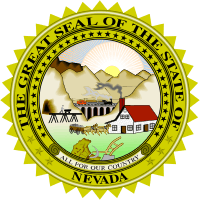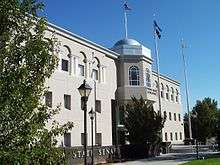Nevada Legislature
| Nevada Legislature | |
|---|---|
 | |
| Type | |
| Type | |
| Houses |
Senate Assembly |
| Leadership | |
Leader of the Senate | |
| Structure | |
| Seats | 63 |
Political groups |
Democratic Party Republican Party Libertarian Party |
| Elections | |
Last election | November 4, 2014 |
| Meeting place | |
 | |
| Nevada State Capitol, Carson City | |
| Website | |
| http://www.leg.state.nv.us | |
The Nevada Legislature is the state legislature of the U.S. state of Nevada. The Legislature is a bicameral body, consisting of the lower house Nevada Assembly, with 42 members, and the upper house Nevada Senate, with 21 members. All 63 members of the Legislature are elected from an equal amount of constituent districts across the state. The Legislature is the third smallest bicameral state legislature in the United States (the Alaska Legislature is the smallest bicameral, with only 60 members and the Delaware General Assembly has 62 members).
The Legislature meets at the Nevada Legislature Building in Carson City.
Terms of members
Members of the Assembly are elected to a two-year term with term limits of six terms (12 years). Members of the Senate are elected to a four-year term and similarly face term limits of three terms (12 years). Term limits were amended to the Nevada Constitution following a voter referendum in 1996 as reflected in Nevada Constitution, Art. 4, Sec 4.
Legislature defined by law
The Nevada Constitution sets the maximum size of the Legislature at 75 members (Article 15, Section 6), and provides that the Senate may not be less than one-third nor more than one-half the size of the Assembly. As of the 2000 U.S. Census, the number of members for both houses is 63, twelve members below the maximum size as stated in the state constitution.
Sessions and qualifications
The Legislature's first official working day is the first Monday of February following the election. Sessions of the Legislature are biennial, occurring during odd number years. The Nevada Legislature is one of the only four states that have biennial sessions.[1] The Legislature must adjourn sine die each regular session not later than midnight Pacific standard time 120 calendar days following its commencement. Any legislative action taken after midnight Pacific standard time on the 120th calendar day is void, unless the legislative action is conducted during a special session convened by the Governor of Nevada. The governor is obligated to submit the proposed executive budget to the Legislature not later than 14 calendar days before the commencement of each regular session. In order to be elected as a member in either chamber of the Legislature, a person must be a U.S. citizen, at least 21 years of age, a Nevada resident for one year, and a qualified voter in their residing district.
Meeting places

For seven years after Nevada's admission as a U.S. state in 1864, the Nevada Legislature did not have a proper meeting place. In 1869, the Legislature passed the State Capitol Act, signed into law by Governor Henry G. Blasdel, providing $100,000 for the construction of a capitol building. Under the supervision of designer Joseph Gosling, construction began on the Italianate building in 1870. The Legislature first convened in the unfinished state capitol building the following year, with construction completed by the middle of the year. The Legislature continued to meet in the state capitol until 1971, when both chambers moved to the Legislative Building constructed just south of the original capitol. Today, the old state capitol continues to hold the office to the governor and other executive branch officials. The former Assembly and Senate chambers are now museums and open for meetings.
History
Sadie Hurst (1857–1952) was the first woman elected to the Nevada Legislature (R-Washoe), in 1918.[2] When the legislature met in special session on February 7, 1919 to ratify the Federal Suffrage Amendment, it was Hurst, the assemblywoman from Reno, who presented the resolution. She had a further distinction of being the first woman to preside over a state Legislature during the ratification of the Federal Suffrage Amendment.[3]
See also
| Wikisource has original text related to this article: |
References
- ↑ http://www.ncsl.org/research/about-state-legislatures/annual-versus-biennial-legislative-sessions.aspx
- ↑ "Fact Sheet" (PDF). Nevada Legislative Counsel Bureau. November 2013. Retrieved 7 March 2014.
- ↑ Blackwell, Alice Stone (1919). The Woman Citizen (Public domain ed.). Leslie Woman Suffrage Commission. pp. 797, 1009–.
External links
- Nevada Legislature
- Facts about the State of Nevada
- Leaders and Members of the Assembly
- Leaders and Members of the Senate